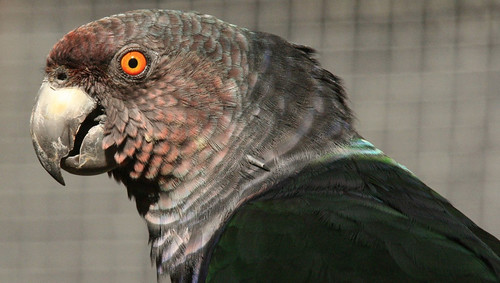 1 of 2 captive Sisserou. This one at the Botanical gardens in Roseau September 2017 and the media is packed back to back with hurricane news. Harvey, Irma and Maria have devastated the Caribbean region. Puerto Rico and Dominica seems to be exceptionally hard hit as we await the reestablishment of contact with these regions that lost most ways of communicating with the outside world.
1 of 2 captive Sisserou. This one at the Botanical gardens in Roseau September 2017 and the media is packed back to back with hurricane news. Harvey, Irma and Maria have devastated the Caribbean region. Puerto Rico and Dominica seems to be exceptionally hard hit as we await the reestablishment of contact with these regions that lost most ways of communicating with the outside world.
First reports tell of great loss of human live and untold millions in damages. We stayed in Dominica for 2 weeks just about a year ago. We frankly fell in love with this island nation and are worried sick about the lovely people we met there. Stephen Durand is safe but out of state and has not heard from his family yet. I can’t imagine his anguish. Besides the people, we have another worry: the parrots. Hurricane David in 1979 was responsible for the near extinction of the Imperial parrot or Sisserou. Throwing the population back to about 40 individuals. This slow reproducing species had just recovered from that event with a population of perhaps over 300 birds in 2015.
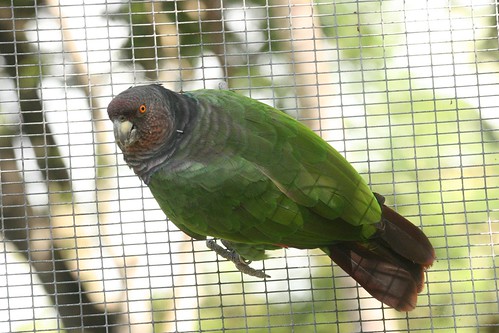 The imperial parrot is in imminent threat of extinction after hurricane Maria his the island on monday
The imperial parrot is in imminent threat of extinction after hurricane Maria his the island on monday
Judging from the damage seen from fly by planes we are back at square one with this parrot. The Red necked Amazon or Jaco had a far bigger population of at least 1500 birds, and uses a wider range of habitats on the island. There are 2 Sisserou in captivity. One in the botanical garden on Dominica, the state of which we don’t know. Another is with RARE in Florida, itself hit hard by Hurricane Irma. The Sisserou never performed well in captivity and attempts to establish it all failed. The one captive bred chick that is now in Florida is said to be in suboptimal health. Jaco have bred occasionally at the facilities in the Botanical garden. We can only hope they are okay.
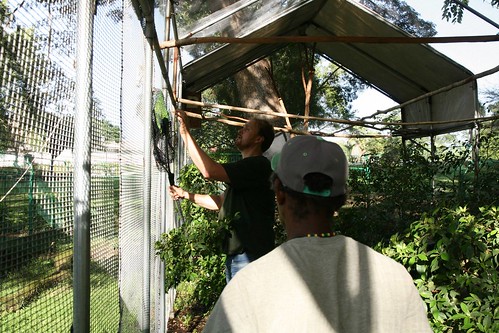 Author helping out in the Botanical gardens where the Jaco and Sisserou are on display
Author helping out in the Botanical gardens where the Jaco and Sisserou are on display
hurricane shelter
In Puerto Rico two consecutive hurricanes have devastated the region. We are also awaiting word from friends on that island. Once the rarest parrot on earth, the Puerto Rican parrot or Iguaca, was doing well after decades of struggling on the brink of extinction. Reintroductions in lowland regions were very successful and hopefully the species will maintain a foothold amidst this fury of nature. In any case, the intensive conservation programme on the island has continued and unlike Dominica, Puerto Rico has facilities to shelter the captive population against the forces of nature. If that facility preformed as designed there is a fall-back population and quick reestablishment on the island can be expected. Even if the complete wild population has been destroyed.
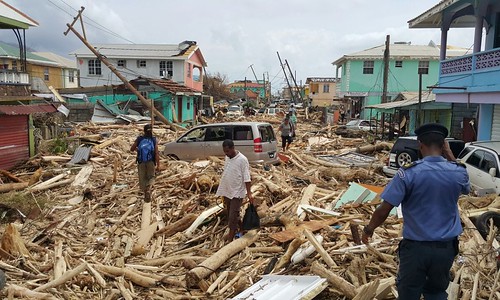 The devastation in Roseau, the capital of Dominica is complete. Notice the trunks in the streets that where once a forest higher up the hills where the parrots reside.
The devastation in Roseau, the capital of Dominica is complete. Notice the trunks in the streets that where once a forest higher up the hills where the parrots reside.
Continued threat
I am not a religious person, but for the Sisserou we can now only pray that anything has prevailed. It will be weeks before we get any understanding of their situation. Any birds that have survived the hurricane itself now face a defoliated remnant of a forest where food in the form of arboreal fruit will be hard to get by. Hunger and exposure to migrating raptors will bring a second blow to this population to which we stand powerless. Birds may stray into towns looking for food as was reported in similar instances in the past. There, they face stray dogs and cats as the parrots come down to the floor looking for food. The massacre of these parrot populations is still unfolding.
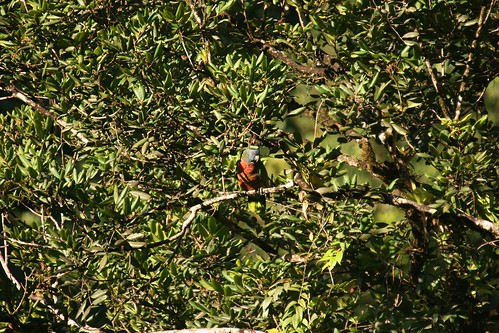 St. Lucian parrot is closely related to the Jaco on Dominica and historically formed a meta-population with this and other similar parrots on adjacent islands
St. Lucian parrot is closely related to the Jaco on Dominica and historically formed a meta-population with this and other similar parrots on adjacent islands
Future
If and when there are any Sisserou or Jaco left in 6 months from now, what can we do? Big trees that will hold nest cavities are now rare to non-existent. Sisserou are big birds, needing big mature trees to breed. Food will be scarce for years to come as saplings need to mature before they become productive. The birds are however long lived and if Dominica is spared another hurricane in the coming decade and none of the volcanos erupt, then the population may rebound on its own. But with the effects of climate change bringing such catastrophically events to the region in increasing frequencies and strength, this does not seem a safe bet.
Another effect of climate change is that the region is experiencing more droughts. Altering the composition of the forest. This sways the conditions in favour of the Jaco at the expense of the Sisserou’s Alpine cloud forest habitat. 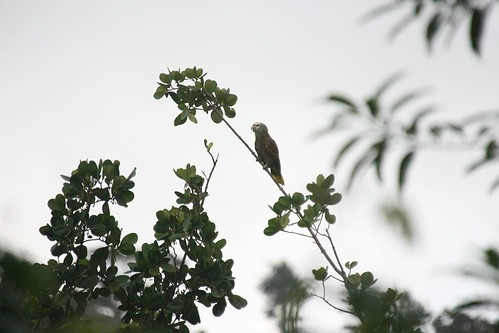 The St. Vincent parrot is more distantly related to the Imperial amazon but it too could be devastated by a direct hit from a category 5 hurricane to the island
The St. Vincent parrot is more distantly related to the Imperial amazon but it too could be devastated by a direct hit from a category 5 hurricane to the island
Meta-populations
The dire straits the Sisserou finds itself in today is not new. Hurricanes are part and parcel of its evolutionary history. The imperial parrot is the last representative of an ancient strain of amazon parrots and the species itself is older than the island where it now resides. Meaning that it partly evolved somewhere else and when that island disappeared trough erosion or when the population was swept away by a hurricane or catastrophic volcanic event, they had already established a new population on Dominica. Sisserou-like parrots are known from Marie-Galante and Guadeloupe where they are presently extinct. The imperial parrots on these other islands may have been another species but they were closely related. These meta-populations of (closely) related species is still evident in the Jaco which is clearly a close relation of the Saint Lucia parrot. Other islands like Martinique used to harbour a similar species.
 Red-necked Amazon parrots fly over with the Saints in the background. All these Caribbean islands are very close to each other.
Red-necked Amazon parrots fly over with the Saints in the background. All these Caribbean islands are very close to each other.
Continued Survival
The continued survival of the Caribbean species will depend on the reestablishment of these meta-population dynamics. These islands come and go. Catastrophic volcanic eruptions and hurricanes mean that no population is ever secure on any one island. Only by a process of colonialization, local extinction and re-colonialization will these strains of unique parrots in the Caribbean survive and continue to evolve. Their conservation is a regional effort not just one state’s burden.
Intensive conservation measures needed
For now, however, we face a more immanent task ahead. That is to safe the Sisserou and Jaco on Dominica. The coming years we need to grow the populations so that we have surplus birds that can be utilised to reintroduce the species to the neighbouring islands. Only then can we have some piece of mind as for the long time survival of these bird. They need close monitoring, hurricane shelter, supplemental nest boxes and food. Growing and planting essential tree species so that they can once again feed themselves and natural nests may develop. It is a financial burden Dominica is unlikely to be able to carry itself after the devastation of this island nation. The international community needs to chip in if we want to see these species survive.